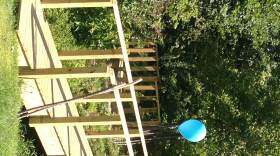

A new cancer center is showcasing what it has to offer to patients in Western Massachusetts.
In recent days, more than a thousand medical staff, patients, and local residents have been touring Berkshire Health Systems’ new Cancer Center. BHS has completed phase one of a $30 million project to consolidate cancer treatment into the retrofitted former hospital at its Hillcrest Campus on Tor Court in Pittsfield. The four-story, nearly 50,000 square foot building consolidates Berkshire Hematology Oncology physician practice, along with Berkshire Medical Center’s chemotherapy and drug infusion site, pharmacy, and blood drawing center. Surgical services will remain at Berkshire Medical Center. Anne McDonald is the Director of Oncology Services for BHS. She says the idea behind the center was to consolidate patient needs into one building, making it easier and more accessible to receive necessary care.
“We understand both the physical and emotional fatigue that results for patients by both the anxiety of the diagnosis and treatment as well as the fatigue that results from therapies,” McDonald said. “So we’ve been very deliberate in bringing services together, being thoughtful of how we can conserve physical and emotional energy for patients by providing what they need as efficiently as possible.”
Joe LaRoche has been working on the project since mid-2011 as the Director of Facilities and Construction for BHS. He says the building includes energy systems that will pay for themselves in less than three years, allowing it to operate at a cost of 30 percent less than the average facility of its kind.
“If an average temperature in a space or particular office is equal to the outside air temperature at the time with the relative humidity, the system knows that it can take outside air and not use mechanical cooling or heating to provide the temperature in the space because it’s identical to what’s outdoors,” said LaRoche.
McDonald says the planning process involved creating a comfortable and functional work environment for staff.
“We’ve installed rubber floors which the nurses will be less fatigued at the end of the day because anyone who knows a nurse knows they are up on their feet all day, every day,” said McDonald.
Along with state-of-the-art medical equipment, the center features flat-screen TVs in patient rooms, views of Onota Lake, and a quarter-mile walking path leading to the waterfront.
“We’ve replaced the windows and created this open-air environment, thinking about color schemes that help enhance the serene environment that the Hillcrest Campus builds us,” McDonald said. “We can take our outdoor environment and bring it indoors and yet still maintain the close proximity of the nurse professionals to take good care of patients.”
While the phase one portion of the center won’t be operational for another month, LaRoche says it has garnered overwhelming praise so far.
“I had a patient say to me on a tour, that he was recently diagnosed and just coming to the center, he was feeling better,” LaRoche said. “For me that was all worth it.”
Vicky Russin-Nash’s non-Hodgkin’s lymphoma is in remission. She has been receiving treatments at the current hematology site off Dan Fox Drive but will be treated at the new cancer center once it’s completed.
“The views into the garden and around, it’s a very comfortable setting,” Russin-Nash said. “You don’t have to worry about a hospital setting. It’s nice when you can everything centered in one place. People don’t have to run from this building to that building, or to some office.”
Slated to be complete by mid-winter, phase two includes adding about 16,000 feet of medical practice space and a health education center that will feature integrative medicine like acupuncture, massage therapy, and exercise. The final phase will be a 12,000 square foot radiation oncology center to be finished in late 2014. McDonald says the center will allow some of the roughly 700 patients BHS diagnoses with cancer each year to stay in the area, without sacrificing quality of care.
“Many people leave our community today to get that kind of care,” said McDonald.



